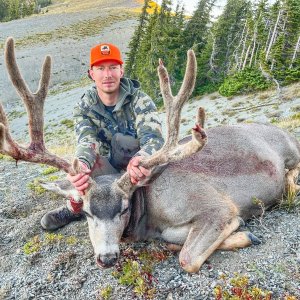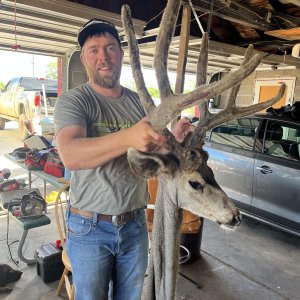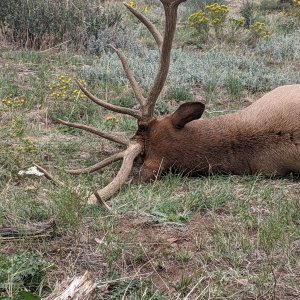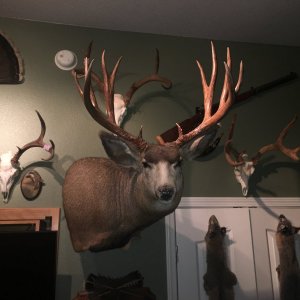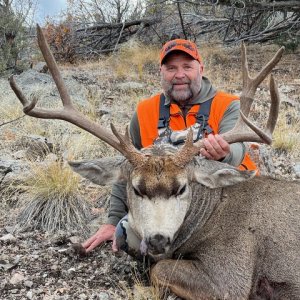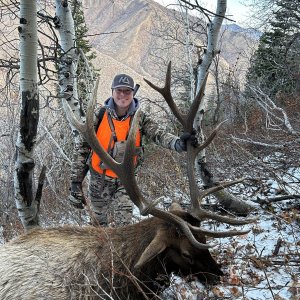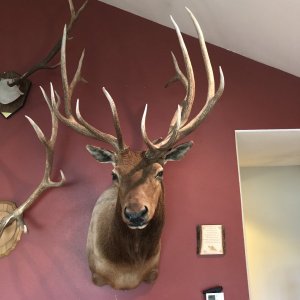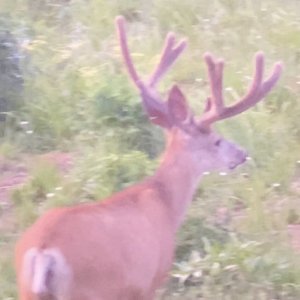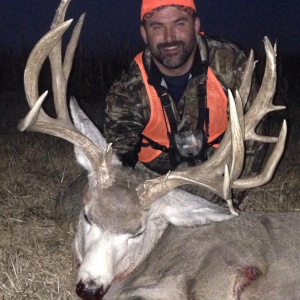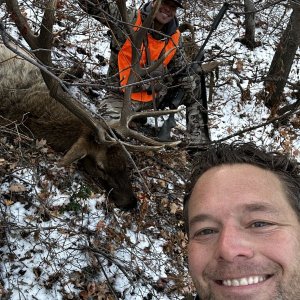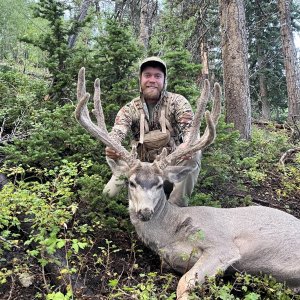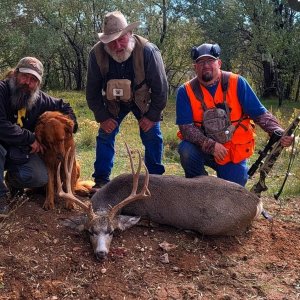As I was driving up 12th street in Ogden this morning I passed 6 Colorado Division of Wildlife trucks, 3 of which were hauling empty horse trailers, headed East toward Ogden Valley. There was one UDNR truck leading the way. Now I don't know exactly what they have planned but in the past I know that this is an area that they have trapped/netted Moose to trade with Colorado for big horn sheep. I do know that the moose got hit hard last winter up here. My parents live in Ogden Valley and made regular "Sunday drives" to Causey resevoir last winter and spring. I tagged along a couple times also. We saw more dead moose than dead deer and elk combined. I know 3 different guys who had 2008 moose tags for the area. They all had a hard time finding moose worthy of a once in a lifetime tag. Compared to the 2 guys I know who hunted in '07 that had there choice of multiple good bulls. As I was hunting deer and elk myself I saw far fewer moose in '08 than I have in the same areas in the past. Anyway my point is, why are they going to take moose again with the numbers already down and this winter shaping up to be just as bad as last? I do realize that me just seeing these trucks in no way confirms anything but I think it is a pretty good guess as to what they are doing. I guess they could be after turkeys. Doubt it though.
You are using an out of date browser. It may not display this or other websites correctly.
You should upgrade or use an alternative browser.
You should upgrade or use an alternative browser.
Bye Bye Moose???
- Thread starter FlyFool
- Start date
T
thebuckstopshere
Guest
Plain and simple, in the DWR mind any moose is worthy of a once in a lifetime tag.
JakeH
Long Time Member
- Messages
- 4,323
I know 2 people that had north slope summit tags this year, and they couldnt find a decent moose anywhere, both ended up shooting little ones towards the end of the hunt, after hunting hard and even rideing horses back into area that you cant get to in a vehical.
I know people that have had tags in the same area over the last several years and most of the time they got good ones.
Whats the difference, apperently the DWR went in and trapt a bunch of moose on the unit and sold them to colorado for bighorn sheep.
The number I herd was 50 of them includeing a bunch of the big bulls, but I dont know how true those numbers are.
I dont think the winter was to bad in this area last year, so where did all the moose go.
Jake H. MM Member since 1999.

I know people that have had tags in the same area over the last several years and most of the time they got good ones.
Whats the difference, apperently the DWR went in and trapt a bunch of moose on the unit and sold them to colorado for bighorn sheep.
The number I herd was 50 of them includeing a bunch of the big bulls, but I dont know how true those numbers are.
I dont think the winter was to bad in this area last year, so where did all the moose go.
Jake H. MM Member since 1999.

H
Hunt_Rez
Guest
shouldnt this be in the moose forum?
N
NeverStopHuntin
Guest
Does anyone know what the trade off is? Is it one moose to one sheep?
I know we just recieved a ton of bighorn sheep from montana. Just wondering what we traded them to get all those sheep.
I am in favor of bringing more sheep to utah (as long as they don't get wiped out by disease like in provo area). But when they are trapping animals to trade they should hit several locations and not catch several moose out of one area or unit.
I know we just recieved a ton of bighorn sheep from montana. Just wondering what we traded them to get all those sheep.
I am in favor of bringing more sheep to utah (as long as they don't get wiped out by disease like in provo area). But when they are trapping animals to trade they should hit several locations and not catch several moose out of one area or unit.
Ticks N Tines
Very Active Member
- Messages
- 1,652
They need to go to the Morgan/South Rich unit and take some moose from there instead. The winters aren't half bad up there and last year on the opener of the Muzzy Deer, I saw six bulls. On other occasions I have seen twice as many moose as I have seen Deer. The moose up by Causey have a hard winter and there's always a half dozen that end up floating in Causey and a bunch more that fall off of cliffs, and that's not counting just the winter killed ones.
The DWR will snatch them up from the easiest access point, which is Causey right now. There are several cows and bulls within 100-200 yards of the road right now and that's the easist bet. Heaven forbid the DWR to do a little work, it's all about getting money ASAP. Who cares about the herd numbers? : (
The DWR will snatch them up from the easiest access point, which is Causey right now. There are several cows and bulls within 100-200 yards of the road right now and that's the easist bet. Heaven forbid the DWR to do a little work, it's all about getting money ASAP. Who cares about the herd numbers? : (
ColoradoOak
Very Active Member
- Messages
- 1,920
So did anyone watch it? I assume they are headed for the new herd being established in the Flattops in CO?
The Grand Mesa area will have its first moose season this year after the introductions from UT which began a few years ago. Thanks!
The Grand Mesa area will have its first moose season this year after the introductions from UT which began a few years ago. Thanks!
Ticks N Tines
Very Active Member
- Messages
- 1,652
>HJB
>???
>I am sure that Causey is
>in the Morgan/South Rich Unit!
What I meant was the Henefer/Echo area.
>???
>I am sure that Causey is
>in the Morgan/South Rich Unit!
What I meant was the Henefer/Echo area.
I watched the 10pm news. They didn't show anything. checked KSl.com today, nothing. I did talk with a neighbor of my parents who got to see them bring down a couple moose with the helicopter over by Anderson Cove (for those who know the area). Now I am not opposed to trading the animals away and am happy to hear that there is going to be a moose hunt thanks to animals brought from our state, I am just concerned that this herd is going to be hurting alot if they take to many. I have heard from many sources (wildlife officials included) that the numbers are way down in this area from previous years. mostly due to this past winter. I hope the UDNR is smart enough to to figure this out, maybe take a few animals from multiple units/areas. I am not holding my breath though.
Fox 13 had a story on it during the 0600 news. I didn't catch if there was a trade with Colorado but they mentioned the biggest reason this SMALL group of moose were going to Colorado was because they keep wandering into the houses/yards/streets.
According to the DWR spokesman moose dislike vehiclar accidents as much as people do?!?
?Here?s to the hero's that Git-R-Done!!?
According to the DWR spokesman moose dislike vehiclar accidents as much as people do?!?
?Here?s to the hero's that Git-R-Done!!?
This was on the front page of the Ogden Standard-Examiner today:
HUNTSVILLE -- Sixteen moose from the mountains above Ogden got a one-way ticket to Colorado on Thursday, courtesy of the Utah Division of Wildlife Resources.
Wildlife managers used a helicopter and a net gun to round up the animals before conducting a medical checkup and trucking them east.
Last winter, the DWR was swamped by calls from Ogden Valley residents reporting moose in residential areas, said DWR public affairs coordinator Phil Douglass.
Thursday's effort was aimed at reducing the number of animals wandering into the valley in search of food, he said.
"I believe we moved over 50 moose (last winter from residential areas)," he said.
DWR officials also met Thursday in Salt Lake City to hear changes to the department's emergency feeding policy for deer during extreme winters.
Officials outlined five triggers that will determine when emergency feeding will take place.
Wildlife managers determined earlier this year the population of moose in the Weber/Ogden canyon area is more than the land can support.
A survey of moose in the Ogden unit, roughly all of Weber County, found about 430 animals, Douglass said.
In Thursday's capture area, officials had counted about 200 moose, many bedded down in drainage areas.
That number is alarming, said Darren DeBloois, a DWR biologist for the Cache and Ogden units.
Most of the moose captured Thursday came from Weber Canyon, he said.
"We tried to get them from an area where they would end up being in residential areas or near the highway," Douglass said.
The captured moose will be taken to the White River Valley area outside of Meeker, Colo., DeBloois said. They will be used to bolster two populations in the region.
The division also increased the number of hunting permits for moose cows from 10 to 20, DeBloois said.
Feeding concerns
Concern for big-game animals this winter was also on Thursday's agenda of the Utah Wildlife Board.
Justin Dolling, mammals program coordinator for the DWR, presented a new set of criteria to be added to the division's Emergency Big Game Feeding Policy.
The additions are in response to an increase in public interest last year, as well as disagreements within the wildlife community on when emergency feeding is necessary, he said.
"Whenever folks see animals struggling and trying to forage out in deep snow, it gets emotional. We had a fair amount of public inquiries (last winter) about whether we should feed or whether we started too late," he said.
"Certain regions of the DWR said it was necessary to feed -- others said it wasn't -- when conditions were very similar," Dolling said.
"It became imperative there needed to be a little more guidance leading up to those decisions."
Dolling outlined five triggers that could indicate when emergency feeding is necessary. If three of those triggers are met, he said, the division will begin distributing feed pellets to the animals.
Officials don't believe the triggers are being hit yet, but Dolling said DWR will continue to monitor conditions over the next month and will be ready to act should the need increase.
The new policy will be tried out for two years, then revised, he said.
Feeding the deer is expensive. Dolling said it costs about $50 to feed a single deer for 60 days.
When to feed wildlife
These are the five triggers the Utah Division of Wildlife Resources will use to determine when it should start feeding large wildlife in winter conditions. Reaching three of the five triggers will spur DWR to action:
1. Body condition of deer going into winter as determined by xiphoid fat measurement in the sternum. Less than10 mm is the trigger.
2. Rate of body condition decline through winter, checking xiphoid fat of road-killed prime deer. Less than 2 mm is the trigger.
3. Availability of forage, primarily shrubs, when feeding locations are covered by snow.
4. Ability of big-game animals to access foliage; mean snow depth in feeding locations should be 20 inches or less.
5. Extreme cold temperatures; when mean daily temperatures at feeding locations are 10 degrees F below 30-year average.
HUNTSVILLE -- Sixteen moose from the mountains above Ogden got a one-way ticket to Colorado on Thursday, courtesy of the Utah Division of Wildlife Resources.
Wildlife managers used a helicopter and a net gun to round up the animals before conducting a medical checkup and trucking them east.
Last winter, the DWR was swamped by calls from Ogden Valley residents reporting moose in residential areas, said DWR public affairs coordinator Phil Douglass.
Thursday's effort was aimed at reducing the number of animals wandering into the valley in search of food, he said.
"I believe we moved over 50 moose (last winter from residential areas)," he said.
DWR officials also met Thursday in Salt Lake City to hear changes to the department's emergency feeding policy for deer during extreme winters.
Officials outlined five triggers that will determine when emergency feeding will take place.
Wildlife managers determined earlier this year the population of moose in the Weber/Ogden canyon area is more than the land can support.
A survey of moose in the Ogden unit, roughly all of Weber County, found about 430 animals, Douglass said.
In Thursday's capture area, officials had counted about 200 moose, many bedded down in drainage areas.
That number is alarming, said Darren DeBloois, a DWR biologist for the Cache and Ogden units.
Most of the moose captured Thursday came from Weber Canyon, he said.
"We tried to get them from an area where they would end up being in residential areas or near the highway," Douglass said.
The captured moose will be taken to the White River Valley area outside of Meeker, Colo., DeBloois said. They will be used to bolster two populations in the region.
The division also increased the number of hunting permits for moose cows from 10 to 20, DeBloois said.
Feeding concerns
Concern for big-game animals this winter was also on Thursday's agenda of the Utah Wildlife Board.
Justin Dolling, mammals program coordinator for the DWR, presented a new set of criteria to be added to the division's Emergency Big Game Feeding Policy.
The additions are in response to an increase in public interest last year, as well as disagreements within the wildlife community on when emergency feeding is necessary, he said.
"Whenever folks see animals struggling and trying to forage out in deep snow, it gets emotional. We had a fair amount of public inquiries (last winter) about whether we should feed or whether we started too late," he said.
"Certain regions of the DWR said it was necessary to feed -- others said it wasn't -- when conditions were very similar," Dolling said.
"It became imperative there needed to be a little more guidance leading up to those decisions."
Dolling outlined five triggers that could indicate when emergency feeding is necessary. If three of those triggers are met, he said, the division will begin distributing feed pellets to the animals.
Officials don't believe the triggers are being hit yet, but Dolling said DWR will continue to monitor conditions over the next month and will be ready to act should the need increase.
The new policy will be tried out for two years, then revised, he said.
Feeding the deer is expensive. Dolling said it costs about $50 to feed a single deer for 60 days.
When to feed wildlife
These are the five triggers the Utah Division of Wildlife Resources will use to determine when it should start feeding large wildlife in winter conditions. Reaching three of the five triggers will spur DWR to action:
1. Body condition of deer going into winter as determined by xiphoid fat measurement in the sternum. Less than10 mm is the trigger.
2. Rate of body condition decline through winter, checking xiphoid fat of road-killed prime deer. Less than 2 mm is the trigger.
3. Availability of forage, primarily shrubs, when feeding locations are covered by snow.
4. Ability of big-game animals to access foliage; mean snow depth in feeding locations should be 20 inches or less.
5. Extreme cold temperatures; when mean daily temperatures at feeding locations are 10 degrees F below 30-year average.
T
thebuckstopshere
Guest
LAST EDITED ON Jan-09-09 AT 11:28AM (MST)[p]Last night KSL said that took 16 meese from this herd. They also said that the meese were exchanged for sheep from Colorado.
I was wrong, I guess, I just reread the story and it appears that Utah just gave these moose to Colorado. It talked about trades in the past.
I was wrong, I guess, I just reread the story and it appears that Utah just gave these moose to Colorado. It talked about trades in the past.
Ticks N Tines
Very Active Member
- Messages
- 1,652
>its in there also
Yes I know, but there is a long way between Causey and Echo. The moose over by Causey suffer a long harsh winter with deep snow, while the ones close to echo have a more mild winter.
I'm not talking about actual "Units", I'm talking about areas that have have a lot of moose. The terrain up next to Causey is nothing like that of the Henefer/Echo area. Different area, different moose, and different numbers.
Yes I know, but there is a long way between Causey and Echo. The moose over by Causey suffer a long harsh winter with deep snow, while the ones close to echo have a more mild winter.
I'm not talking about actual "Units", I'm talking about areas that have have a lot of moose. The terrain up next to Causey is nothing like that of the Henefer/Echo area. Different area, different moose, and different numbers.

